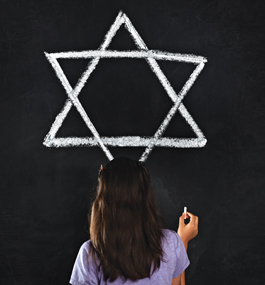When Teaching About Israel, Giving Children a Voice

iStock
by Lawrence Goodman
How do American Jewish elementary-school kids view Israel? How do their views change over time? And, equally important, what should we be teaching them about Israel?
The American Jewish community is spending “unprecedented time and money” cultivating Jewish teens’ and young adults’ connections to Israel, says Jon Levisohn, director of the Jack, Joseph and Morton Mandel Center for Studies in Jewish Education. The same is not true for elementary-school kids.
As a consequence, Levisohn says, “we know an awful lot about how younger kids typically think about subjects like math, but when it comes to Israel we don’t really know anything.”
In 2012, Levisohn became intrigued by a new project launched by social scientist Sivan Zakai, who was interviewing kindergartners at three Los Angeles Jewish schools about their views on Israel. Zakai, the Sara S. Lee Chair in Jewish Education at Hebrew Union College, became an affiliated scholar at the Mandel Center, and her research became the basis for the center’s Children’s Learning About Israel project.
In all, Zakai interviewed 35 kids as they progressed from kindergarten through the fifth grade. She is writing a book based on her research, provisionally titled “Gazing Towards Zion: American Jewish Children and the State of Israel.”
“There are over 1.8 million Jewish children living in American Jewish households,” she says, “and their voices are generally silent or spoken for by others in policy and political discussions, and sociological research. I wanted to give a voice to the children.”
Zakai documents how kids’ ideas change over time as they grow. Kindergartners are more discerning than parents and teachers typically give them credit for, she says — they are able to understand fairly sophisticated ideas even before they can read fluently.
For instance, “Samantha,” a child profiled in Zakai’s book, as a 6-year-old kindergartner cannot remember a time when she didn’t know about the Israeli-Palestinian/Arab conflict, which she calls “the war in Israel.” “[My] mom talked about it when I was in my mom’s tummy,” Samantha says, “so I learned.”
By the second grade, Samantha has begun to view the conflict not as a war throughout time between Israel and its enemies, but as a very specific conflict between Israel and its closest neighbor, which is “trying to steal Israel.” When she talks about the conflict, she is confident of only one thing: that “Israel’s trying to make peace. They don’t want war.”
In fourth grade, Samantha’s views on the conflict undergo a radical transformation. “We can’t judge every [Palestinian] just on how [some Palestinians] behave,” she explains, insisting it is only “some Palestinians [who] are not nice to the Jews.” In her revised position, it is not Palestinians but the conflict itself that is a problem. She frames the situation this way: “Palestinians are fighting the Jews and the Jews are fighting the Palestinians, and it’s not good.”
By the end of fifth grade, Samantha is still frustrated and repeatedly talks about how worried she is about the long-standing tensions. Yet she still believes in the possibility of peace: “If you do end up putting [my views on the conflict] in a book, you should always have an optimistic spin, saying, ‘[The conflict] might happen now … but we know the Jews will make peace.’”
Zakai believes her work will give educators a deeper understanding of how children think about Israel as they grow — a good thing for kids and teachers alike.
